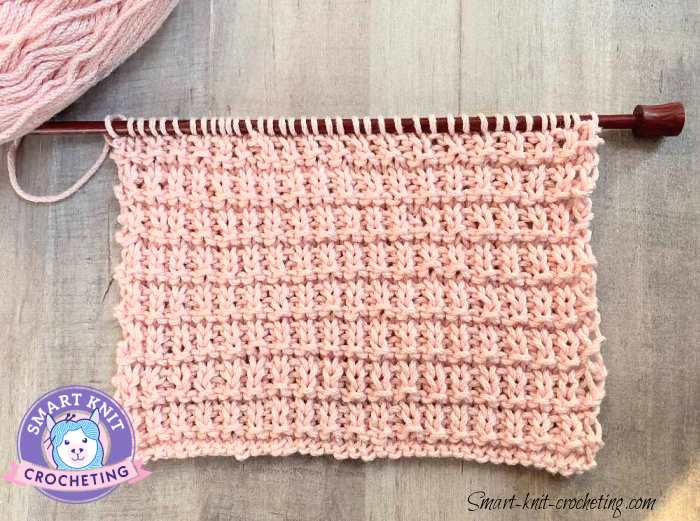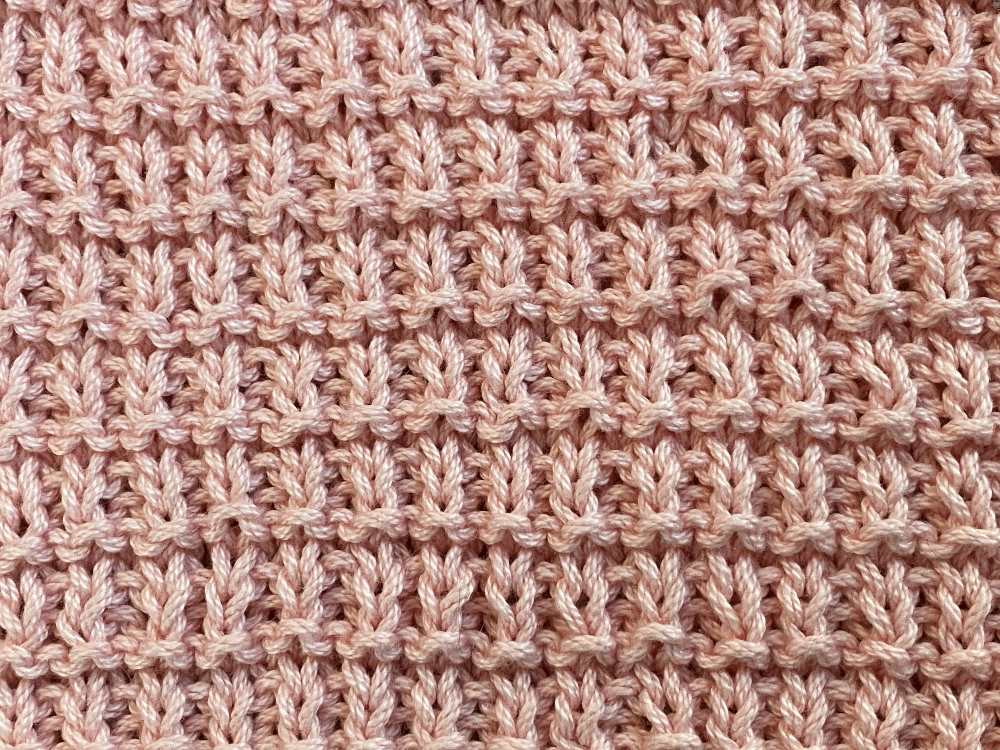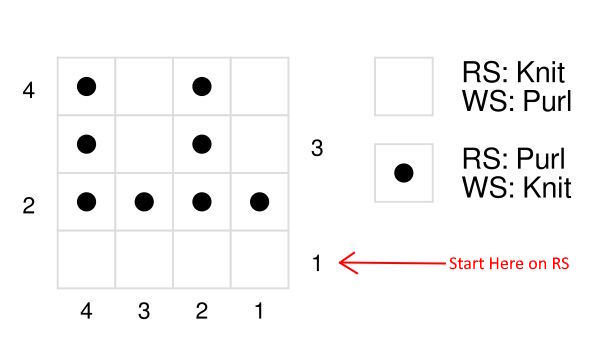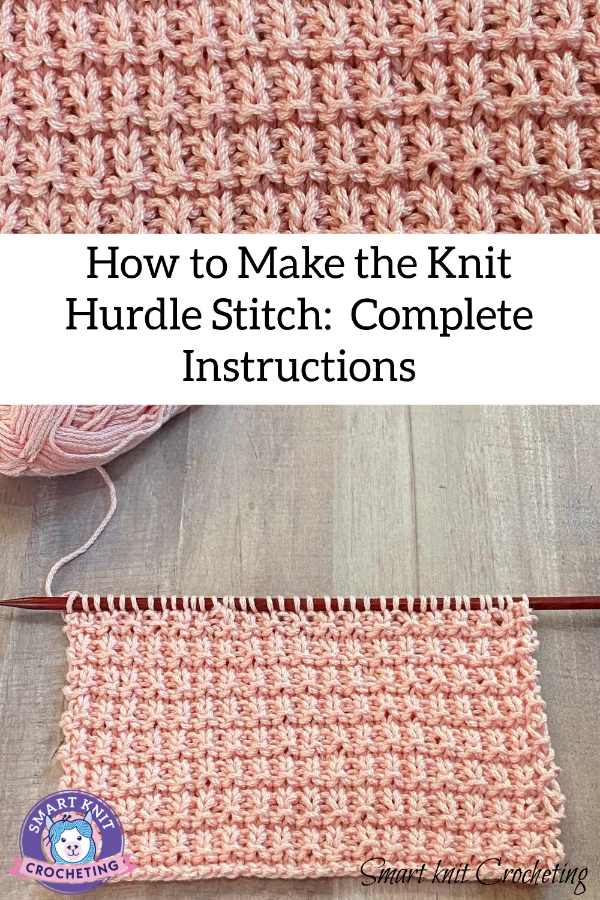- Home
- Types of Knit Stitches
- Knit and Purl Stitches
- Knit Hurdle Stitch
How to Make the Knit Hurdle Stitch
by Janice Jones
Reading Time: 4 minutes
The knit hurdle stitch is a simple, beginner-friendly stitch pattern. This pattern alternates between two rows of garter stitch and two rows of 1x1 rib stitch. It's ideal for projects requiring thick texture, even edges, and a flat-laying fabric without a border.
If you're new to knitting, you don't need to limit yourself to garter or stockinette stitch patterns. The knit hurdle stitch is a great option to try. I really love this pattern because it is so easy to memorize and perfect for knitting while watching television.
Download your free pdf tutorial or keep reading.
 I used a 100% cotton yarn to create this swatch.
I used a 100% cotton yarn to create this swatch.Many knit and crochet stitches are named based on their appearance. In this case, the two rows of knit stitches form the "hurdles," which looks similar to the obstacles or barriers that horses jump over or dogs in an agility course.
Understanding its unique features can help you decide how to incorporate it into your projects.
What's so Special About the Knit Hurdle Stitch?
- Suitable for Beginners: The knit hurdle stitch is easy to learn and execute, making it an excellent choice for beginner knitters who have mastered the basic knit and purl stitches.
- Reversible: Unlike many other knitting stitches, the knit hurdle stitch creates a fabric that looks identical on both sides. This makes it ideal for projects where both sides of the work will be visible, such as scarves, blankets, or dishcloths. More Reversible Stitches
- Thick texture: The combination of garter stitch and 1x1 rib stitch creates a thick, textured fabric that is both visually appealing and functional. This texture adds depth and interest to the finished project.
- Even edges: This fabric lies flat without requiring a border. This can save time and effort when working on projects that require a neat, tidy edge such as scarves.
- Flat lay: Despite its textured appearance, the knit hurdle stitch produces a fabric that lies flat without curling or rolling at the edges. This is particularly useful for projects like dishcloths, placemats, or blankets, where a flat surface is desirable.
Uses for the Hurdle Stitch
Since this pattern is reversible, this stitch is useful for many projects:
- Knit dishcloths or face cloths (See the free pattern below)
- Blankets
- Rugs
- Placemats
- Pillows
- Scarves and Cowls
More Stitch Tutorials For You
- Easy Knit and Purl Stitches
- Textured Knit Stitches
- Reversible Stitches
- 4-row Repeat Stitch Pattern
How is the Knit Hurdle Stitch Pattern Created?
You can use circular needles or flat knitting to make this stitch pattern.
The hurdle knit stitch pattern is worked on an even number of stitches and is a four-row repeat pattern. Think of the first two of the four-row repeat as a simple garter stitch.
Skills Needed
Knit Hurdle Stitch Instructions

You can use any yarn and corresponding needles for this tutorial, but if you follow these instructions, you will eventually create a lovely 100% cotton facecloth or dishcloth.
This pattern and tutorial use US terms.
Abbreviations
This pattern and tutorial uses U.S. terms.
Here are the abbreviations that I used.
CO = Cast On
K = knit
P = purl
sts = stitches
BO = Bind Off
RS = Right Side
WS = Wrong Side
* * Repeat the instructions between the two asterisks for the number of times indicated.
Swatch Instructions
You may decide to practice with these swatch instructions, or scroll down to the facecloth pattern and practice by making a dish or face cloth.
- Cast on an even number of stitches.
- Row 1 and 2: K all sts.
- Row 3: *K 1, P1* across the row
- Row 4: *K 1, P1* across the row
Repeat rows 1 through 4 until you reach your desired length. To create a dishcloth/facecloth, the finished project size is 7 inches square. BO after row 1 knit all stitches.
Directions for Making a 7" Facecloth
Supplies Needed
For the purposes of this tutorial, I used the following supplies:
- 100% Lily Sugar 'n Cream 100% Cotton, worsted weight yarn
- US size 8 (5.0 mm) straight knitting needles
- Scissors
- Tapestry Needle to weave in ends.
Finished Measurements
The finished dishcloth / facecloth measures 7 inches by 7 inches (17.8 by 17.8 cm).
To make this project larger, add 6 stitches for every inch you want to add. So for example if you want an 8 inch cloth, CO 44 sts. instead of the 38 inches suggested below.
Skill Level

Instructions
CO 38 stitches
Row 1 and 2: K all sts.
Row 3: *K 1, P1* across the row
Row 4: *K 1, P1* across the row
Repeat rows 1 through 4 until you reach your desired length. To create a dishcloth/facecloth, the finished project size is 7 inches square. BO after row 1 knit all stitches.
Weave in ends.
How to Read a Knit Stitch Chart
For basic stitch patterns, written instructions are generally enough, but it is always a good idea to become familiar with knitting charts. This is how the chart would look for the Hurdle Stitch.
Remember, you start reading at the lower right edge where you see the number one. This is the first row and is also the right side. The second row (wrong side) is worked from the left to the right.
The key at the side of the chart tells you how to identify how to read each stitch.
 The Knit Hurdle Stitch Instructions in Chart form.
The Knit Hurdle Stitch Instructions in Chart form.Frequently Asked Questions
What projects are best suited for the knit hurdle stitch?
What projects are best suited for the knit hurdle stitch?
The knit hurdle stitch is versatile and can be used for various projects, such as dishcloths, face cloths, blankets, rugs, placemats, pillows, scarves, and cowls.
What skills do I need to know before attempting the knit hurdle stitch?
What skills do I need to know before attempting the knit hurdle stitch?
To work the knit hurdle stitch, you should be familiar with casting on, knit stitch, purl stitch, binding off, and weaving in ends.
How do I adjust the size of my project when using the knit hurdle stitch?
How do I adjust the size of my project when using the knit hurdle stitch?
To adjust the size of your project, add or subtract 6 stitches for every inch you want to add or remove from the width. For example, if you want an 8-inch wide dishcloth instead of the 7-inch one described in the pattern, cast on 44 stitches instead of 38.
Last Words
The knit Hurdle Stitch is an ideal pattern for beginning knitters because it only requires one to know how to create knit and purl stitches. Other skills needed are how to cast on and bind off. Since it lies flat and is reversible, it is perfect for any project needing those attributes including scarves, dishcloths and blankets.
It looks like a rib stitch and it does have a one by one rib component. Chose this stitch for your next knitting creation.
Happy Knitting, Smart Knitter
Janice
Free Downloadable PDF
Would you like a free pdf of this knit hurdle stitch tutorial? Click to get your free copy.
Knit Hurdle Stitch Tutorial: Pin for Future Reference
About Janice
Hi, I’m Janice, the voice behind Smart-Knit-Crocheting. I love to knit and crochet and even more, I love teaching others what I know.
Though I learned to knit and crochet as a child, I didn’t get serious about these amazing hobbies until I retired. I’m a certified knit and crochet instructor through the Craft Yarn Council and am working on becoming a Master Hand Knitter through The Knitting Guild Association.
I’m currently living with my husband of over 50 years and our 6 Shih Tzu dogs.
I love hearing from you, so please drop me a line and let me know what you’re working on, whether you love knitting or crocheting more, and if you have any questions. Please visit my about me page for more information.
Happy Crocheting







